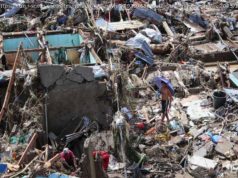In the end, Hurricane Harvey’s most powerful weapon was the rain. For five days, the storm hovered over Houston and southeast Texas, dumping more…
In the end, Hurricane Harvey’s most powerful weapon was the rain.
For five days, the storm hovered over Houston and southeast Texas, dumping more than 50 inches of water in the state’s most populated region.
Inch by accumulated inch, more than 20 trillion gallons of water pooled in southeast Texas, swamping hundreds of thousands of homes, cutting off roads, displacing more than 30,000 people and spurring more than 13,000 rescues.
The death toll, which stood at 42 late Friday, could have been much higher, as many had feared.
But Harvey’s long-term legacy might not be the deaths caused or even the destruction created but its economic, social and environmental impact. In its wake, the storm of the century leaves the lingering threat that severe, sustained and frequent flooding can and will cripple this major American city and destroy a critical global energy center.
Prior to Harvey’s landfall that threat was theoretical. But no longer. The storm clouds have moved on and the receding floodwaters are beginning to reveal the full extent of the destruction left behind. And questions are already being raised about how Houston and the nation will prepare for the next massive flood.
“We need to look closely at how this catastrophic failure happened and make sure it doesn’ t happen again, ” said Barbara Minsker, chair of the Civil and Environmental Engineering Department at Southern Methodist University.
“Are we just going to do the same thing, put the same stuff back up, which will just last until the next flood? Or are we going to look to the next century? It shouldn’ t be just business as usual, ” Minsker said.
Widespread flooding
Jeff Lindner, meteorologist for the Harris County Flood Control District, which covers the city of Houston, said Friday that Harvey flooded an estimated 136,000 structures in Harris County, or 10 percent of all structures in the county database. He called it a conservative estimate, one that doesn’ t include the flooding along 315 miles of Texas coastline from Corpus Christi to Port Arthur.
Seventy percent of Harris County’s land mass, or about 1,300 square miles, was submerged by at least 1½ feet of water, he said. The heaviest rainfall was around Clear Creek at Interstate 45 in the southeastern part of the county, near the NASA Johnson Space Center.
The forecasting service AccuWeather predicted Harvey’s damage will reach $190 billion, or a full 1 percent of U. S. economic output. After 2005’s Hurricane Katrina, federal aid exceeded $110 billion. Gov. Greg Abbott said during a news conference last week that Texas will need far more money.
President Donald Trump, at a visit to Corpus Christi last week, also predicted that recovery would be „a costly proposition.“
“There’s never been anything so expensive in our country’s history, ” Trump said.
“There’s never been anything so historic in terms of damage and in term of ferocity as what we’ ve witnessed with Harvey.” Monstrous storm
Hours before Harvey made landfall, the mayor pro tem of Rockport, a fishing and tourist town 30 miles northeast of Corpus Christi, spoke in dire terms, warning any resident choosing not to flee to “mark their arm with a Sharpie pen with their name and Social Security number.”
On Friday evening, the monstrous storm slammed into Texas’ gulf coast as a Category 4 hurricane with sustained winds of 132 mph, devastating beach towns like Rockport and Port Aransas and other rural communities.
But the worst was yet to come.
Lingering over Houston, the nation’s fourth largest city, Harvey’s record rainfall — the most ever recorded from a single storm in the United States — proved catastrophic.
Hammered by rain for four days, the city of Houston, a metropolitan area of 6.6 million, was overwhelmed by flooding. The rising water quickly inundated the city’s system of bayous, flood channels and rivers. Roads and major highways became impassable. Pipelines ruptured. The city’s two major airports shut down, as did several hospitals, water purification plants and oil refineries.
Harvey’s path
The slow-moving storm would meander around southeast Texas crawling toward San Antonio before reversing course and heading back to the Gulf early Monday morning as a tropical storm.
Wednesday morning it swerved back, strafing the Texas-Louisiana border more than 300 miles from where it first came ashore near Corpus Christi. Downgraded to a tropical depression, the storm moved through Mississippi and reached Tennessee on Friday.
Images of disaster and heroism captured the world’s attention. For every human or animal needing help, it seemed there were an equal numbers of rescuers. Texans with boats raced to Houston, joined by their neighbors in Louisiana, the so-called “Cajun Navy.” They saved entire families from flooded homes, rescued the elderly from retirement centers and saved more than a few dogs, cats and even deer from the muddy waters.
Americans, both individuals and businesses, opened up their hearts and wallets, contributing hundreds of millions of dollars in donations and in-kind services. Much went to big disaster relief agencies, like the Red Cross, but many also contributed to hyperlocal charities, including a variety of pet rescue causes. History of flooding
Harvey produced Houston’s third “500-year” catastrophic flood in three years, destabilizing communities with deep roots like Meyerland, a neighborhood with almost 15,000 households in the city’s southwest side.
Last year, The Texas Tribune and ProPublica examined how Houston’s rapid growth and lack of zoning have made it more vulnerable to hurricanes and torrential rainstorms.
The city is a hostage to its geography. Flat and just 50 feet above sea level, the Houston metro area and its satellite communities cover about 10,000 square miles, an area larger than Maryland or New Jersey. It’s crisscrossed by a network of 1,700 miles of channels, creeks and bayous that drain into the Gulf of Mexico, about 50 miles to the southeast from downtown.
Over the years, Houston and its suburbs have become the classic “mega-city, ” SMU’s Barbara Minsker said. But simply building more and more pavement, homes and high-rises “without offsetting the increased runoff will continue to worsen both flooding and heat problems, ” said the civil and environmental engineering expert.
“Coastal cities along the Gulf are vulnerable to hurricanes,’ Minsker said. “That’s not going to go away.”
Houston, which has always taken a hands-off approach to zoning, needs to look hard at where it permits residential development. “We shouldn’ t rebuild in flood zones, ” Minsker said.
Even without regulations, local, state and federal officials can use tax incentives and create public-private partnerships to create green spaces, including large-scale wetlands that can capture rainwater. Permeable pavement that soaks up water instead of producing run-off is also a tactic being used elsewhere in the country, she said.
These approaches can be more costly up-front than simply rebuilding but more efficient in the long-term when compared to the cost of rebuilding and repairing after multiple catastrophic floods.
It can be a pivotal moment for Houston. But will it be?
“An event like this can provide the political will to do things like this, but you have to move fast because people forget, ” Minsker said.
Start
United States
USA — Events After Harvey's destruction, will a new and different Houston emerge?






